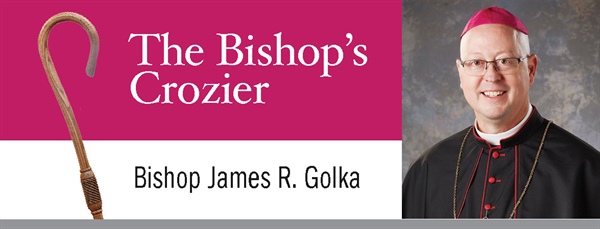THE BISHOP'S CROZIER: The Two Parts of Advent
By Bishop James R. Golka

On the evening of Nov. 26, the Church throughout the world will usher in the season of Advent and the beginning of a new Church year. It is important to remember that there are two parts of Advent. These two parts have very distinct meanings.
The first part looks to the future. The second looks to the past. They both help us to live in faith in the present.
Part One is from the beginning of Advent until Dec. 16. The liturgy, scripture readings and focus of this part of Advent demand that we open our eyes — wake up — and expect the coming of the Messiah. This does not refer to the birth of Jesus 2000 years ago. The beginning of Advent asks us to look to the future for the Second Coming of Christ. This part of Advent has little to do with remembering the Christ child born in Bethlehem. That will come later. This first part is more serious in tone. We listen in anticipation, expectation, hope and promise that Christ will come in the future to fulfill and complete the reign of God.
Advent is not a time when we pretend to be the people awaiting the Messiah’s arrival. During Advent we recall the stories of our ancestors in faith who lived with such expectations and eventually saw them fulfilled when Jesus was born. We are not waiting for the birth of a savior. He is already born into our world at that first Christmas. During Advent the stories of our ancestors become our own story. We remember these great stories because they give us hope today as we now prepare for the Second Coming of Christ.
Listen to the last lines of the book of Revelation (the last book of the Bible): “The Spirit and bride say ‘Come.’ Let the hearer say ‘Come.’ . . . Amen! Come, Lord Jesus! The grace of the Lord Jesus be with all.” (Rev. 22:17, 20-21). The Bible ends with this great invitation to the Lord to come again and make our world right. The first part of Advent turns our eyes towards this future coming of Christ. We must make ready to receive the Lord when he comes again.
Part Two of Advent is from Dec. 17-24. These last eight days before Christmas recall the first coming of God in flesh through the birth of Christ. This preparation teaches us an important lesson about Christmas. God was born into our world and took on our flesh. This incarnation continues to unfold in our current time and place. Christmas does not simply remember a past event as if it were over and done with. Christmas encourages us to live in hope and faith that God will continue to enter our world and bring about God’s reign.
St. John Paul II said, “The liturgy of Advent . . . helps us to understand fully the value and meaning of the mystery of Christmas. It is not just about commemorating the historical event, which occurred some 2,000 years ago in a little village of Judea. Instead, it is necessary to understand that the whole of our life must be an ‘advent,’ a vigilant awaiting of the final coming of Christ. To predispose our mind to welcome the Lord who, as we say in the Creed, one day will come to judge the living and the dead, we must learn to recognize him as present in the events of daily life. Therefore, Advent is, so to speak, an intense training that directs us decisively toward him who already came, who will come, and who comes continuously.”
As Advent approaches, let us live in joyful and spiritual expectation for the coming of our savior, Jesus Christ.
Watch Bishop Golka's Reflection video on the first week of Advent: https://www.youtube.com/watch?v=QHy78lLo_GQ
1144